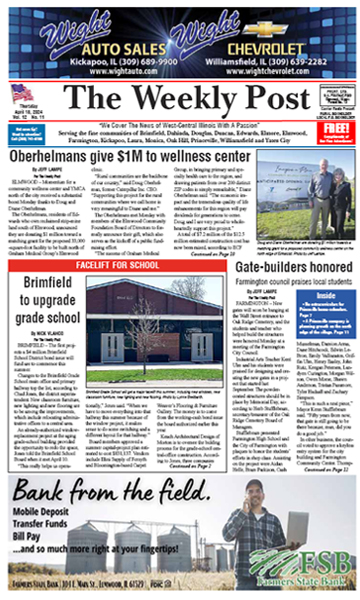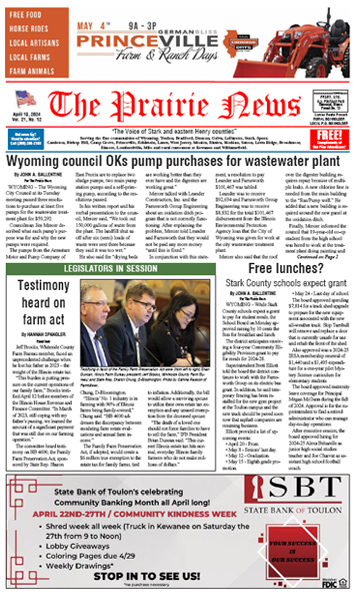By BILL KNIGHT
For The Weekly Post
Rural communities had about 900,000 fewer jobs this August than August of 2019, according to the Bureau of Labor Statistics (BLS). However, the outlook is improving from earlier this year, and rural America is holding on to jobs better than urban or suburban areas. Besides the number of jobs, the average jobless rates also are better in rural areas than metro areas.
In The Weekly Post area, Fulton, Knox and Peoria Counties all lost jobs in the year-to-year comparison, but the percentage declines in Fulton and Knox weren’t as bad as the national average, while Peoria was worse.
BLS’ October report showed 12-month declines of jobs in rural areas of 6.4 percent in July and 4.3 percent in August. That’s not good, of course, but it’s improving in the midst of the pandemic.
Urban and suburban areas between August 2019 and August 2020 showed job losses of 8 percent and 6.9 percent, respectively. Nationally, data released Oct. 15 showed 898,000 new unemployment claims in the week ending Oct. 10, seasonally adjusted. That marked 30 consecutive weeks of 800,000-plus claims – since mid-March.
More than 27 million people have used state or federal aid through mid-October (almost 18 percent of the labor force, according to Press Associates, Inc.), and as state jobless benefits ran out, as well as the $600 weekly federal supplements, many have been forced to seek Illinois’ 20 weeks of extended benefits.
“With the last round of federal unemployment bonuses running out in mid-September and no further stimulus plan in sight, the unemployment numbers for especially impacted industries remain volatile,” says Casey Peterson, Director of Rural Outreach and Development with the Greater Peoria Economic Development Council.
But some communities in rural counties have avoided large-scale job losses. “Many of our locally owned businesses are run efficiently, meaning they have a smaller number of employees who wear multiple hats so layoffs become more difficult to make,” says Amy Davis, Economic Development Director for the City of Elmwood. “I also feel, from conversations with long-time businesses, that their dedication to their employees makes layoffs an absolute last resort, and thanks to local businesses’ receiving Paycheck Protection Program loans, many were able to keep employees on their payrolls when they may have had to make that tough decision to send employees home.”
Peterson see cities that benefit from travelers and hotel business being vulnerable during the pandemic. “Larger metro areas reliant on hospitality and tourism continue to fare much worse overall,” he says. “Coronavirus has given rural communities with access to natural resources like state parks and recreation areas an opportunity to diversify their economic outlook. With people from all walks of life doing their best to follow guidelines but also wanting to get out of the house, the outdoors are a natural draw for those looking to enjoy the fall weather.”
The great outdoors can be a great for local economies, says Brent Baker of Trail Advocates of Central Illinois. “Trails and the other natural resources that rural communities have in spades offer a powerful economic engine not only for COVID-19 recovery, but for sustainable economic development into the future,” he comments. “As an example, look no further than the Rock Island Greenway that connects Peoria and Tazewell counties. Over the last five years, the economic impacts of the Rock Island Greenway have been powerful.”
But the COVID-19 pandemic has slowed other types of recreation, especially
if the activities are distant destinations requiring air travel. Six of the top 10 job declines among rural counties depend on such recreation: Mono County, Calif.; San Juan County, Wash.; Denali Borough, Alaska; Skagway City, Alaska; Teton County, Wyo.; and Dickinson County, Iowa. However,
hometown recreation, sight-seeing close by, and brief breaks from “stay-cations” help rural economies, and jobs.
“Since the start of the pandemic, we’ve seen surging demand nationwide
for safe, close-to-home spaces where people can be active outside,” said Ryan Chao, President of the national Rails-to-Trails Conservancy, last week.
Also, farm country is somewhat protected from many negative job trends.
“Our region echoes national trends in employment numbers by industry,” says Peterson, with the Greater Peoria EDC. “Counties and communities
that are heavily reliant on agriculture have generally fared better as far as employment goes. The USDA and the $23.5 billion Farm Bill passed in March played a major stabilizing role. “
In Elmwood, Davis agrees, adding, “Agricultural jobs are less influenced
by things like a pandemic because once the crop is in the ground harvest
is inevitable and all of the individuals who are part of that and anything down the line from there are needed. Worst-case scenario is fewer hands doing the same work but again most farming operations that I see locally are already running very efficiently. That doesn’t mean the market will be kind, but the work still needs to be done.”
BILL KNIGHT can be reached at bill.knight@hotmail.com
Copyright © 2023 illinoisweeklies.com







